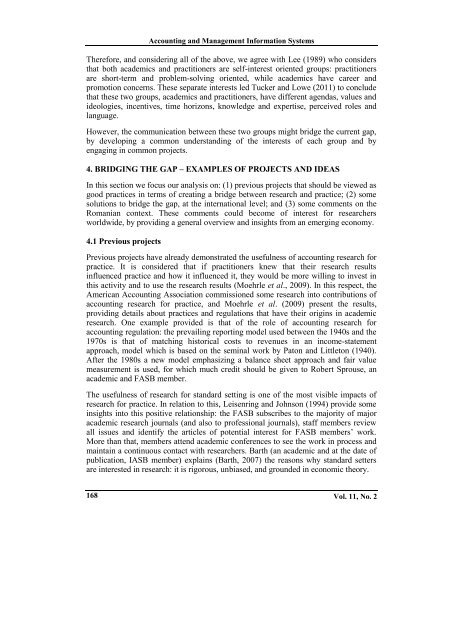bridging the gap between accounting academic research and practice
bridging the gap between accounting academic research and practice
bridging the gap between accounting academic research and practice
You also want an ePaper? Increase the reach of your titles
YUMPU automatically turns print PDFs into web optimized ePapers that Google loves.
Accounting <strong>and</strong> Management Information SystemsTherefore, <strong>and</strong> considering all of <strong>the</strong> above, we agree with Lee (1989) who considersthat both <strong>academic</strong>s <strong>and</strong> practitioners are self-interest oriented groups: practitionersare short-term <strong>and</strong> problem-solving oriented, while <strong>academic</strong>s have career <strong>and</strong>promotion concerns. These separate interests led Tucker <strong>and</strong> Lowe (2011) to concludethat <strong>the</strong>se two groups, <strong>academic</strong>s <strong>and</strong> practitioners, have different agendas, values <strong>and</strong>ideologies, incentives, time horizons, knowledge <strong>and</strong> expertise, perceived roles <strong>and</strong>language.However, <strong>the</strong> communication <strong>between</strong> <strong>the</strong>se two groups might bridge <strong>the</strong> current <strong>gap</strong>,by developing a common underst<strong>and</strong>ing of <strong>the</strong> interests of each group <strong>and</strong> byengaging in common projects.4. BRIDGING THE GAP – EXAMPLES OF PROJECTS AND IDEASIn this section we focus our analysis on: (1) previous projects that should be viewed asgood <strong>practice</strong>s in terms of creating a bridge <strong>between</strong> <strong>research</strong> <strong>and</strong> <strong>practice</strong>; (2) somesolutions to bridge <strong>the</strong> <strong>gap</strong>, at <strong>the</strong> international level; <strong>and</strong> (3) some comments on <strong>the</strong>Romanian context. These comments could become of interest for <strong>research</strong>ersworldwide, by providing a general overview <strong>and</strong> insights from an emerging economy.4.1 Previous projectsPrevious projects have already demonstrated <strong>the</strong> usefulness of <strong>accounting</strong> <strong>research</strong> for<strong>practice</strong>. It is considered that if practitioners knew that <strong>the</strong>ir <strong>research</strong> resultsinfluenced <strong>practice</strong> <strong>and</strong> how it influenced it, <strong>the</strong>y would be more willing to invest inthis activity <strong>and</strong> to use <strong>the</strong> <strong>research</strong> results (Moehrle et al., 2009). In this respect, <strong>the</strong>American Accounting Association commissioned some <strong>research</strong> into contributions of<strong>accounting</strong> <strong>research</strong> for <strong>practice</strong>, <strong>and</strong> Moehrle et al. (2009) present <strong>the</strong> results,providing details about <strong>practice</strong>s <strong>and</strong> regulations that have <strong>the</strong>ir origins in <strong>academic</strong><strong>research</strong>. One example provided is that of <strong>the</strong> role of <strong>accounting</strong> <strong>research</strong> for<strong>accounting</strong> regulation: <strong>the</strong> prevailing reporting model used <strong>between</strong> <strong>the</strong> 1940s <strong>and</strong> <strong>the</strong>1970s is that of matching historical costs to revenues in an income-statementapproach, model which is based on <strong>the</strong> seminal work by Paton <strong>and</strong> Littleton (1940).After <strong>the</strong> 1980s a new model emphasizing a balance sheet approach <strong>and</strong> fair valuemeasurement is used, for which much credit should be given to Robert Sprouse, an<strong>academic</strong> <strong>and</strong> FASB member.The usefulness of <strong>research</strong> for st<strong>and</strong>ard setting is one of <strong>the</strong> most visible impacts of<strong>research</strong> for <strong>practice</strong>. In relation to this, Leisenring <strong>and</strong> Johnson (1994) provide someinsights into this positive relationship: <strong>the</strong> FASB subscribes to <strong>the</strong> majority of major<strong>academic</strong> <strong>research</strong> journals (<strong>and</strong> also to professional journals), staff members reviewall issues <strong>and</strong> identify <strong>the</strong> articles of potential interest for FASB members’ work.More than that, members attend <strong>academic</strong> conferences to see <strong>the</strong> work in process <strong>and</strong>maintain a continuous contact with <strong>research</strong>ers. Barth (an <strong>academic</strong> <strong>and</strong> at <strong>the</strong> date ofpublication, IASB member) explains (Barth, 2007) <strong>the</strong> reasons why st<strong>and</strong>ard settersare interested in <strong>research</strong>: it is rigorous, unbiased, <strong>and</strong> grounded in economic <strong>the</strong>ory.168Vol. 11, No. 2
















